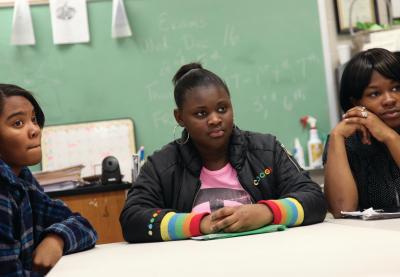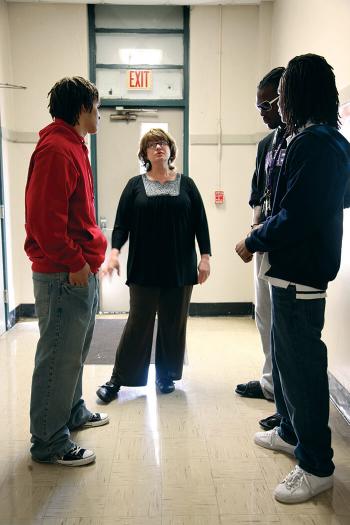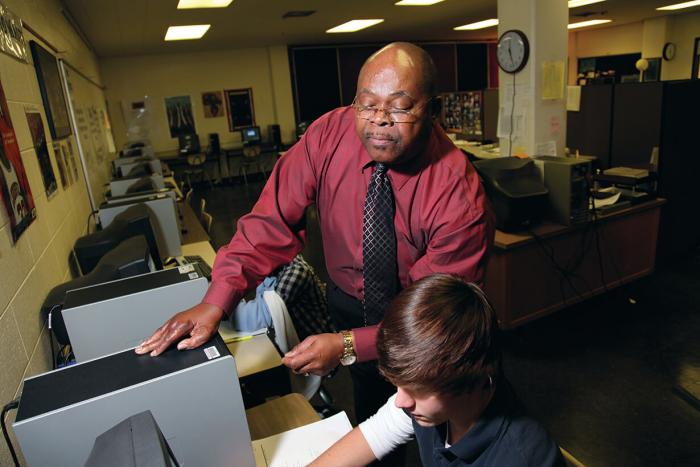Vickie Malone’s students see integration when they gather in her classroom at McComb (Mississippi) High School. Black and white youngsters talk and study with peers they’ve known since elementary school.
But Malone doesn’t want her students to see integration. She wants them to think about it, to understand their families’ roles in the struggle that, to some extent, continues in their Mississippi town.
She doesn’t want them to learn history; she wants them to do
history.
She accomplishes that goal by prodding, poking and challenging her students to develop critical thinking skills. She has them troll through public documents and conduct oral histories with community residents. She pushes them to search and search, until they discover that one answer invariably leads to another question.
Malone’s classroom is located in one of the battlegrounds of the Civil Rights Movement — but her dilemma is one faced by teachers all across the country. The Movement happened here, yet there’s more that should have happened. Jim Crow was outlawed, but much is still separate and still unequal. Schools were integrated, but many lives remain segregated.
For the past three years, Malone has taught a class on her town’s local history, inviting students to find out what really happened, and why.
“I create an environment that allows them to do the research and the thinking, and ask the questions,” says Malone, who also teaches psychology and sociology. “But I don’t give them the answers. They arrive there on their own.”
It’s her way of adhering her school’s philosophy of teaching with rigor, relevance and relationship. The rigor comes from conducting research and shaping questions. The relevance comes from showing students how events connect with their own lives. The relationships are the bonds between classmates, students and the people they meet and interview.
Two states away, in Louisville, Ky., Louis Bryant worked at accomplishing the same goal during his 14 years teaching African American history at Ballard High School.
His students didn’t have to go outside the classroom to find primary sources; they talked to one, every time they spoke to Bryant. The Mississippi native was active in the Civil Rights Movement when it came to his home state.
“(The students) were in awe,” he says. “Their minds are eager to learn, and then someone is standing in front of them who had been a part of the movement. It’s a one-on-one thing,” says Bryant, who now serves as a liaison for the school’s online division.
Bryant and Malone have crafted solutions to a problem that plagues any history teacher: making the past relevant to students thoroughly grounded in the present. But teaching the importance of integration is possibly even more vexing, now that public schools are re-segregating at an increasing pace.
Research by the Civil Rights Project at UCLA revealed that 40 percent of Latinos and 39 percent of African Americans go to “intensely segregated schools.” These students are segregated by class as well because “the average black and Latino student is now in a school that has nearly 60 percent of students from families who are near, or below the poverty line,” according to the organization’s January 2009 press release. “After two decades of a hostile Supreme Court, and two terms of a presidency committed to reversing civil rights gains, only the nation’s small towns and rural areas retain substantially integrated schools.”
The trend is evident in Mississippi, which arguably has a dual school system. The public schools are 50 percent African American, 47 percent White and 2 percent Hispanic/Latino. The state also has a sizable system of private schools, most of which have few African American students.
“There are private schools … that have a predominately Caucasian student body, but are in an area that is predominately African American. I think a lot of people are resigned to that reality because they are private schools,” says Chauncey Spears, who directs advanced learning and gifted programs at the Mississippi Department of Education.
“It’s not to say there isn’t a private school option for African Americans, but many can’t afford the tuition, or meet the enrollment requirements,” he says.
Malone and Bryant stand on either side of those lines. Bryant is an African American whose students are predominately white and affluent. Ballard High School is a comprehensive high school that offers courses in six languages, cultural arts and health careers.
Malone is a white teacher whose students are predominately African American, and moderate- to low-income. McComb High School has 815 students, according to its website. The school offers two foreign languages and numerous courses in fine arts.
When it came to civil rights history, however, both said their students shared a trait: ignorance.
“Most of my students came in with no knowledge about the Civil Rights Movement.” Bryant says. “They were blank about it.”
The McComb students bluntly admitted they knew nothing about the tumultuous time in their city.
“I wasn’t really familiar,” Marcus Spears said in a documentary about the school’s civil rights class. “But when we got into the class, I realized the things that happened, it was right in my own neighborhood.”
Malone blames such lack of knowledge on the way subjects are taught. “The reason they don’t know very much is that they learn certain things for tests. The style is stand and deliver,” she says. “They get the information from the teachers, by and large in a factual way. They haven’t had information down to the level where they own it.”
Malone and Bryant agree that promoting ownership requires a specific setting. The class must be student-centered, where the teacher is a leader or guide instead of an authority.
“I let my students have control of the everyday experience, and lead the discussion,” Bryant says. “I lead into it by question and answer.”
The classroom must also become a safe space, because exploring civil rights history exposes intense and conflicting emotions.
Bryant started his classes by setting ground rules about language and behavior.
“My philosophy is respect for one’s opinion. It’s a two-way thing: you give respect and respect comes back to you,” he says.
He also forbids casual use of racial slurs. “We had to get rid of derogatory terms: the n-word, the cracker word. I’m up front. I let them know we will not use those words, and if the words come up in a book then we will talk about them.”
Malone arranges the classroom so everyone is on equal terms. She’s abandoned desks for a table where she joins the students.
“We sit around and table, and I sit with them so we’re all at eye level. Nobody can look at something else, nobody can lay down on the table,” she says.
In fact, the seating arrangement is one step toward creating community. Malone says she spends at least half of the semester creating a trusting, open atmosphere.
“I spend nine weeks building community, so they get a lot of background about when and why (McComb) began,” she says. By the time students get to what Malone calls “the stuff that’s heavy” — issues of family history and ongoing injustice — students are already accustomed to talking in a frank but sensitive way.
Students start by researching their names, and writing a poem about themselves. Then they look into their families and create a real narrative. Relating those stories helps break down defenses that students have erected to protect themselves from their situations, and from each other.
“Before they come in the class, there are lots of attitudes from the boys and the girls,” she says. “Once they begin to share from the heart about their own personal experiences, the kids respond [to each other] in such a different way.”
When the walls begin to crumble, Malone sends her students out once more, to ask about their families’ involvement in civil rights. The stories that come back show why creating community is so necessary.
One of her former students only shared when Malone insisted. He revealed that his family had once gone through his great-grandfather’s belongings. There, stored in the attic, they found a red Klan robe; the student’s relative was an official in the white supremacist organization.
Malone immediately steered the discussion to the student’s feelings.
“We talked about how it makes you feel to know that and the fact that he’s not responsible (for his great-grandfather’s membership). There’s nothing he can do about it, but the awareness makes him a different person,” she says. “We don’t have any control over the past, all we can do is grow from the knowledge.”
As students begin to uncover the injustices of the past, it’s natural for them to feel a certain righteous anger. But that anger plays out in different ways, depending on where the student stands.
“The black students were not angry at the white students; they were angry at the times. They wanted to know, how this could be,” Bryant says. White students, Bryant says, blamed themselves for their grandparents’ behavior.
“I never let any student leave class with their dignity not intact,” he says. “If something is said that offends [any] student, we talk about it.”
The power of the class isn’t in the knowledge transmitted, but in the transformations the students undergo, Malone says.




0 COMMENTS